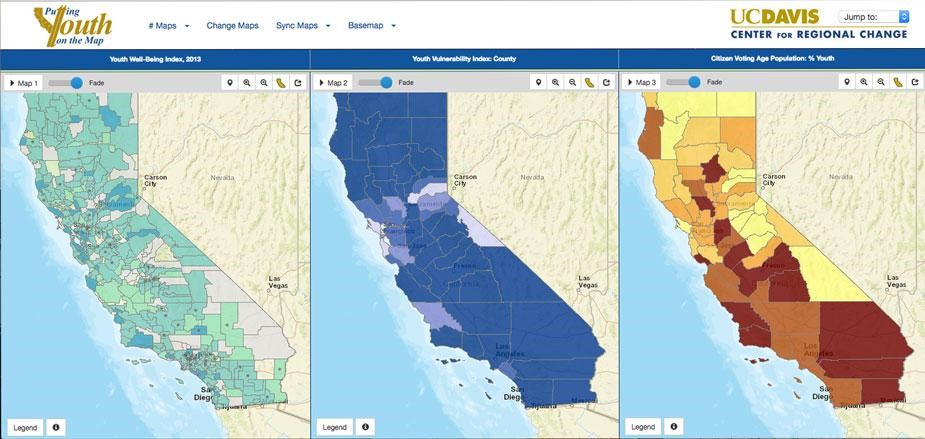By Dave Jones. An interactive website called “Putting Youth on the Map” has landed UC Davis on a different map, as a top winner in the UC system’s annual Larry L. Sautter Award Program for Innovation in Information Technology.
Putting Youth on the Map puts statistical data into map format for use in advocacy efforts aimed at improving the lives of young people in California. The project is led by Nancy Erbstein, assistant research professor in the Department of Human Ecology, and a faculty affiliate with UC Davis’ Center for Regional Change, as principal investigator.
Putting Youth on the Map, or PYOM, “is a powerful information resource for youth and adults working to ensure youth well-being in California,” according to the web tool’s “about” page.
“In the big picture, my goal was to equip our young people — especially those least well served by current policies and systems — and their adult supporters, with data they could use in civic engagement efforts to foster change,” Erbstein said.SE STUDY
She said Putting Youth on the Map provides “real access” to publicly available data that can complement primary data collection and other action to promote youth well-being. “By ‘real access’ I mean not only are the data provided in a user-friendly format, but there are tools to help young people understand and use them,” she said.
According to the website, “Youth and adult advocates can use PYOM to identify issues, mobilize action and hold decision-makers accountable for helping improve young people’s opportunities and outcomes … (and) service providers and private foundations can use PYOM to strategically allocate resources.”
PYOM provides quick visual presentations of California data broken down by city or county or school district or legislative district. The data, from a variety of sources, cover such factors as health, food access, financial resources, truancy and suspensions, age and ethnicity, and access to transportation, and also include scores from the Youth Well-Being Index and the Youth Vulnerability Index, developed by Erbstein and others as part of Putting Youth on the Map.
You choose the statistic you want to display, and the mapping tool turns the data points into different shades of color, so you can easily see, for example:
- High school graduation rates by district, of 0 percent to 29 percent, 30 percent to 39 percent, and so on.
- Numbers and percentages of young people out of work and out of school.
- The percentage of high school graduates completing UC/California State University prerequisite courses.
The mapping tool provides “holistic, place-based indices measuring youth well-being and severe isolation from support,” according to the website.
“Combined with the stories from young people themselves, the PYOM tool can paint a comprehensive picture of youth vulnerability and well-being throughout the state,” states the project’s Sautter award nomination form, submitted by Jonathan London, associate professor, Department of Human Ecology, and faculty director of the Center for Regional Change.
He said nonprofit organizations, government agencies and others “have successfully leveraged the data from this user-friendly tool to guide funders, stakeholders and policymakers to make better decisions for youth.
Erbstein said the Putting Youth on the Map team has included many contributors:
- Estella Geraghty, formerly at UC Davis Medical Center, who served as co-PI during the first year
- Sergio Cuellar, Cassie Hartzog, Gail Lampinen and Sara Watterson, all of the Center for Regional Change
- Sheryl-Ann Simpson, assistant professor, Department of Human Ecology
- Glenda Drew, professor, Department of Design
- Youth development and nutrition-focused staff and academics at UC Agriculture and Natural Resources, and UC CalFresh Nutrition Education Program
- Undergraduate and graduate student interns from the design, public health, sociology, community development and geography programs
“And last, but certainly not least, young equity advocates and their hosts, South Sacramento Building Healthy Communities, Fathers and Families of San Joaquin (Stockton) and Eastern Coachella Valley BHC,” Erbstein said.
Finally, she acknowledged generous support from The California Endowment, UC Agriculture and Natural Resources, the Center for Collaborative Research for an Equitable California and the Sierra Health Foundation.
Dave Jones is the editor of Dateline UC Davis. This article was originally published in the UC Davis newsroom on August 15, 2017. Republished with permission.







